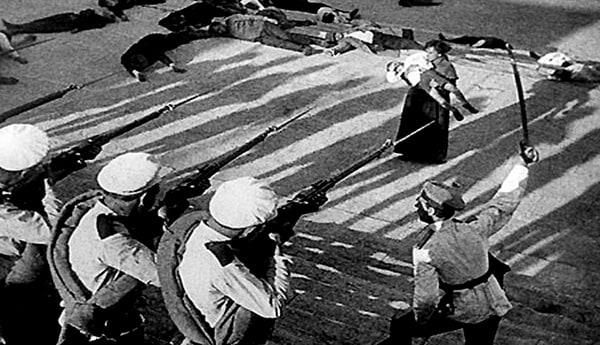– Lenin, 1905.
A dramatized account of a great Russian naval mutiny and a resulting street demonstration which brought on a police massacre.
Aleksandr Antonov: Grigory Vakulinchuk - Bolshevik Sailor
Nazi propaganda minister Joseph Goebbels once spoke about Battleship Potemkin:
"A marvelous film without equal in the cinema ... anyone who had no firm political conviction could become a Bolshevik after seeing the film." That is a brief statement which partly sums up the power of Battleship Potemkin.
The film was not banned in Nazi Germany. Why? I feel it is because the content speaks for itself, it demands respect and attention from enemies and friends alike.
It is an example of perfected propaganda and glorifying art for the cause, capturing the storm of change and the ideological perfection captured upon the screen which invokes the masses to rise up against oppressors.

The mesmerising efforts, films and works of Dziga Vertov and Sergei Eisenstein in the early days of Soviet Union's cinema easily beats anything Hollywood made in the same era. The musical score is a tempest of energy and passion, the imagery retains an intense and avant-garde style and transitions smoothly allow the audience to absorb the clever storytelling.
For Director Sergei Eisenstein cinema was an art with a multitude of reflections thus his concluding montage fuses the meanings of images, words and music into a powerful piece.
A work and labour of ideological patriotic art depicting the struggle of overcoming the artificial confining class system.
Battleship Potemkin is split into five sections:
1) Men and Maggots: This chapter focuses on food and hygiene. The sailors are subjected to poor conditions while the higher ranking officers are not.
2) Drama on the Deck: This chapter focuses on morality and religion which it shows as a distraction or I should say as a form of control. The crew however dismiss superstition when used against their rebellion.
3) A Dead Man Calls for Justice: Addresses the death or martyrdom of the fallen leader/hero Vakulinchuk.
The funeral is used as a political demonstration against the rule of the Tsar.
Community being a potential replacement for an oppressive government.
4) The Odessa Staircase: Shows the evils of the soldiers and regime of the Tsar. Any uprising is killed or suppressed regardless of whether it involves men, women or children. This chapter clearly feels like it is provoking or enticing the audience, which I write about further on as well.
This scene has been an inspiration for many film-makers since this period.
A fine example and tribute from recent years is Terry Gilliam's cult classic Brazil which honours this scene.
Who can forget the pram with the baby descending faster and faster down the steps as the chaos continues to escalate? It is unforgettable.
Even a century after its creation, the chapter on the Odessa staircase is still highly impressive.
5) The rendezvous with the Squadron: The conclusion depicts the glory and patriotism in which the ideology allows freedom for the masses.
There is a sense of productivity, patriotism and unity. No oppression.
Battleship Potemkin offers many beautiful examples of detail and perfect cinematography: The audience are treated to the visual splendor of small and dark rooms where the sailors reside, then alternate between big and light rooms of the tsarist officers.
Beautiful dishes with religious inscriptions for the priviledged bourgeoise on board and the foul dead meat for the sailors (workers/oppressed).
We bare witness on another segment to the sadness of a despaired woman that loses her young child whom is coldly dispatched by gunshot while under the onslaught of pitiless, merciless imperialists. The resulting bloodbath attempts to touch a nerve and provoke the audience into waking up to such chains.
Eisenstein gives you an idea regarding the sheer enormity of these oppressive forces dressed with dramatization, relentlessly descending upon the suffering citizens.
The director and makers are constantly working to breathe life into the ideology by means of stirring up the emotions of his audience, especially in this chapter on the Odessa steps. It is a success in many ways.
Battleship Potemkin focuses on the rebellion and the solidarity of a collective crowd, effectively displaying emotion and expression when focusing on facial expressions or epic ongoings.
This film is a treasure filled with details and perfection from an artistic point of view. Ahead of its time.
10/10
 Login
Login